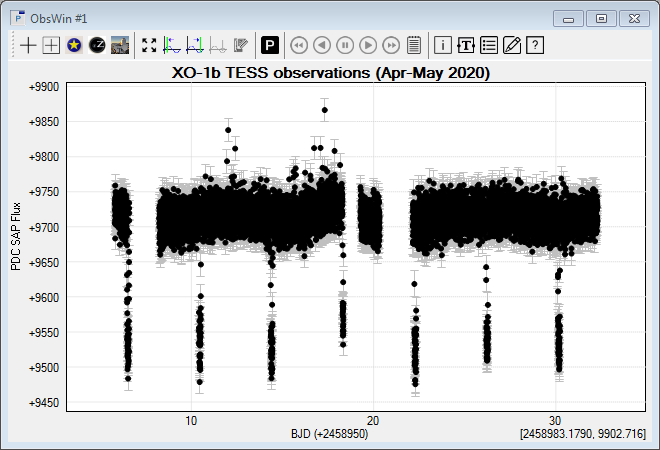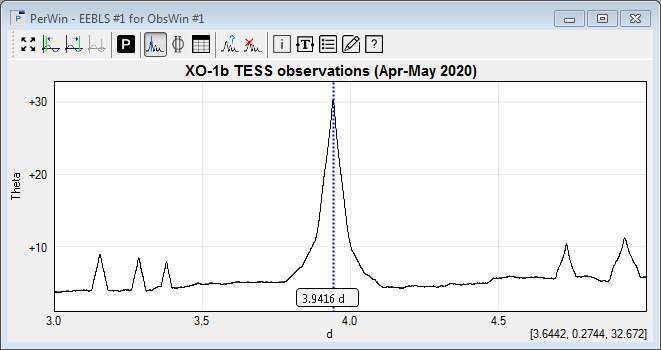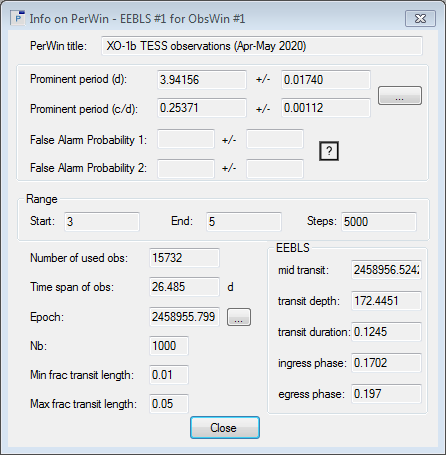- Select Open in the File menu (or click on
 in the main Toolbar) to display the File Open box. Navigate to the Peranso Tutorials 6 folder. To do so, first locate your My Documents folder (typically C:\Users\<your_user_name>\Documents). In there is a subfolder Peranso, then select the subfolder Tutorials. Finally, select the folder 6. Detecting exoplanet transits using EEBLS. Select the file XO-1b TESS and click the Open button. This loads the contents of the file and creates an Observations Window (ObsWin) with caption "XO-1b TESS observations (Apr-May 2020)", showing 15,732 active observations. in the main Toolbar) to display the File Open box. Navigate to the Peranso Tutorials 6 folder. To do so, first locate your My Documents folder (typically C:\Users\<your_user_name>\Documents). In there is a subfolder Peranso, then select the subfolder Tutorials. Finally, select the folder 6. Detecting exoplanet transits using EEBLS. Select the file XO-1b TESS and click the Open button. This loads the contents of the file and creates an Observations Window (ObsWin) with caption "XO-1b TESS observations (Apr-May 2020)", showing 15,732 active observations.
Note that the X axis is expressed in BJD (Barycentric Julian Date) while the Y axis is expressed in PDC SAP flux, with values ranging from 9450 to 9900 flux (energy).

- Performing a visual inspection, we immediately recognize the "dips" in the light curve, which are characteristic for the transits of an exoplanet. Using the Measurement indicator, we find that the transits happen every ~3.9 days.
- We will now perform a more in-depth transit analysis. Click the Period Determination button in the ObsWin toolbar and select the EEBLS method. We select Days and Time and use a Range going from 3 to 5 days (as we know that the likely transit period is ~3.9 days). We immediately select a high number of Steps, 5000. In the Additional parameters section, we select 1000 bins in Nb. We do not modify the other parameters.
The fractional transit length is assumed to be a small number (usually between 0.01 and 0.05) and denotes the time spent in the transit phase, relative to the total transit duration.
We recommend to use rather high numbers of bins with the EEBLS method, as this allows to more accurately determine the transit ingress and egress phases.
Click Apply to start the EEBLS calculation. The EEBLS algorithm aims to find the best model with estimators for the transit period, depth and length, as well as the epoch of mid transit and the phase of ingress and egress.
- This creates a Period Window (PerWin) with the EEBLS spectrum. Using the PerWin Info box, we note that the dominant period is 3.94156 +/- 0.01740 days. The dominant period is the transit period of XO-1b, and corresponds quite well with the literature value of 3.94151 days.


- The Info box contains the regular Peranso PerWin info fields, complemented with some EEBLS specific fields, that indicate :
- the epoch of mid transit (in BJD),
- the transit depth (in PDC SAP flux)
- the transit duration (in days),
- the phase of ingress (transit start),
- the phase of egress (transit end)
|